 |
||
|
||
| ||
In the end of the summer'2001 Intel Corporation decided to radically change the strategy of advancing Pentium 4 processors to markets. Intel decided to cover both performance and mainstream segments Pentium 4 CPU, and to hand value and server markets over to various Tualatin variants. But the problem is that the price of final solution plays rather important role. Not as much as in the budget machines segment, but still the user, spoilt by nowadays cheapness, is not morally ready to pay money just for "pure speed" or "the latest fashion". Usually there are rather expensive, but balanced configuration in this segment. I.e., if there's a possibility of buying something powerful for some lower price, the customer will choose it. The same happened with Pentium 4 and systems on its base in the mainstream segment - the price of solutions was too high, but the perfomance: Well, it's not the question. One had to buy an expensive CPU, expensive motherboard, and shockingly expensive memory. And while the prices of almost all components was lowering, the price of RDRAM was still too high. That even made Intel to supply Pentium 4 "box" processors with RIMM modules. So, the problem was on hands: they had to lower the price of not only CPU, but also of solutions, based on it. The i850 + RDRAM + Pentium 4 bundle had no chances to become popular, but it didn't had that task as well - it was designed for systems, where perfomance was of the highest importance. Pentium 4 and RDRAM combo didn't suit the market for masses, as it was too expensive. So, the need of another chipset, maybe not so productive, but less expensive and supporting other memory types, was large. i850 would have remained for perfomance market segment, where the price is not critical. Intel now prepares to officially release such a chipset, named Brookdale, and we'll devote separate articles to it, but now: Now let's remember that there's such a nice thing on markets like competition. And Intel has a competitor, that doesn't rest on his laurels after the releases of KT133A and KT266. Yes, right you are, it's VIA Technologies. Having skilled engineers as well as rich experience in x86 chipset development, this company has an important advantage comparing to Intel - VIA isn't so much bothered by the fact that it may push aside some old chipsets with new ones, as it hasn't released any in this segment yet. We might even assume that in case this happens, the company wouldn't be so disappointed, as it's way of market. Well, there' actually another thing: licensing. According to some official information, VIA hasn't got the Pentium 4 license from Intel yet. But it's not about this article to discuss the science of law, so, as wise man said, "let's hand all declarations to United Nations", and turn directly to chipsets. One thing is undoubtful: the more chipsets will appear, the wider popularity awaits Pentium 4. And as we guess, they understand it in Intel: Now let's take a closer look at our hero. VIA P4X266 Chipset consists of VT8753 North Bridge and VT8233/VT8233C South Bridge. 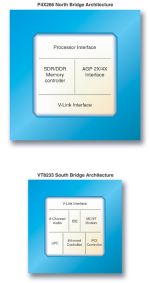 Here are the features:
And now let's compare two Intel Pentium 4 chipsets:
VIA P4X266 Reference board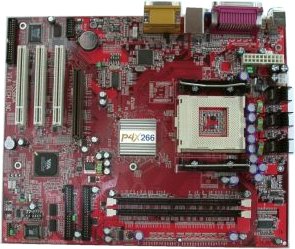 We had got VIA's reference board for testing. As you may notice, engineers tried all efforts to make their brainchild look impressive - red PCB is not so usual for reference motherboards :). As for the rest this product looks ascetic enough - 3 PCI, 1 AGP, 2 DDR DIMM. There's a socket for "big" Pentium 4 (Socket 423), but, as we know, motherboard manufacturers plan mostly Socket 478. BIOS settings do not differ much from usual, so there's no sense in describing them. The general impression is that it's typical reference board, i.e. product that was made to show the work capacity and stability. Such boards are to easily pass even the most complicated tests (and this one did it's job), but not to impress with perfomance. It seems that VIA handed these aspects over to the specialists, i.e., motherboard manufacturers. On the other hand, we might assume that P4X266 has it's speed potential, and that the perfomance of retail boards will be even higher than the perfomance of this one. PerfomanceThe following equipment was used for testing:
We'd like to consider Brookdale board separately. We couldn't withstand the temptation and included its readouts in this test. But we shall note: that's rather "raw" sample, so do not consider these results as final. Software:
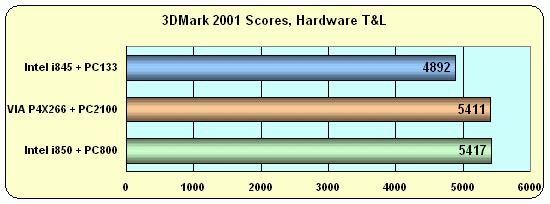  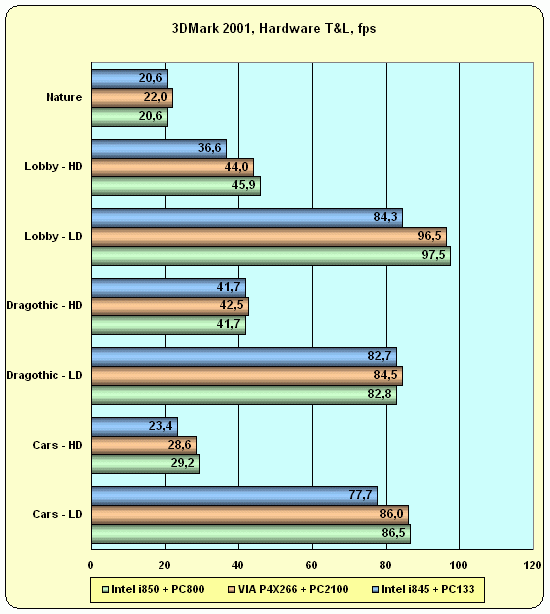 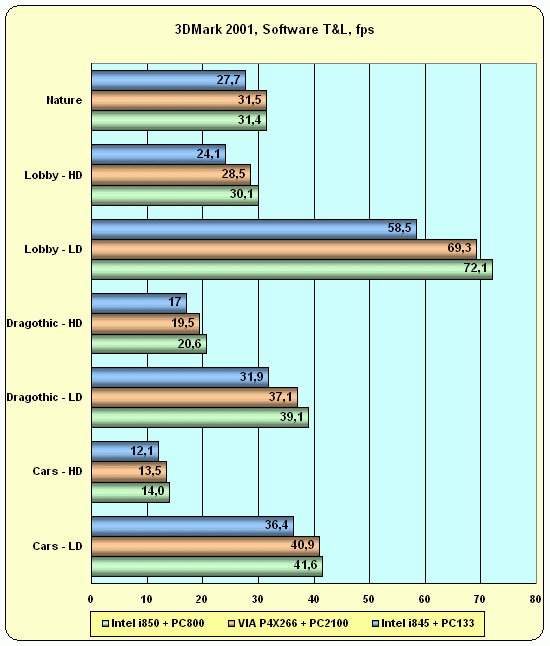 The places allocation is obvious enough: i850 + PC800 RDRAM combo leads in the majority of cases, VIA P4X266 + PC2100 DDR SDRAM is slightly (sometimes very slightly) behind. It's interesting that during tests in Software T&L mode the gap between i850 and it's competitor is higher, than if you use GeForce3 hardware features. It must be about the load of memory subsystem when using Software T&L, and wider bandwidth of i850 also proclaims itself: 3,2 GB/sec comparing to 2,1 GB/sec of VIA P4X266 (we'll just remind that i850 has dual-channel bus with 400MHz clock rate). And, by the way, these results lead us to another conclusion, though not related to the theme of article, but still interesting: it seems that Hardware T&L allows to decrease the load of not only the CPU, but also of the memory subsystem, i.e. it's twice useful.  The situation is the same as previous. Quake 3 is the favourite Intel's test of Pentium 4 advantages in comparison with other "unfriendly" :) products. And looks good here as well, despite the fact that all test systems were equipped with Pentium 4, "pure" Intel & Intel combo is still ahead. And all the chipsets are equal in the 1280x1024 resolution - the memory access speed loses it's importance, and the perfomance rests on GPU. 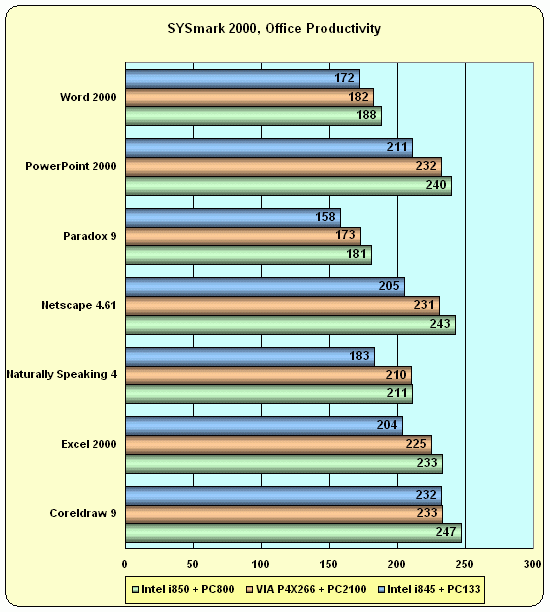  i850 has also shown itself good in traditional test, emulating office routine and internet-content creation (or just some raster/vector graphics and multimedia operations). But VIA P4X266 has had some problems in the some standalone applications like Photoshop. All results may be divided into three groups: the first is "ladder", i.e. P4X266 loses to i850 the same as Brookdale loses to P4X266. In the second i850 is equal to P4X266, and Brookdale loses to them both. And the third at last: i850's ahead and two others lose to it. The "ladder" was observed in seven applications of fourteen, i.e. in the half of the cases. The second variant (the best for P4X266) was observed in two cases only. And the last seems to be somewhere in the middle like, say, "ladder with unequal steps". The general conclusion is illustrated by the most often situation - VIA P4X266 is somewhere between i850 and Brookdale. But let us not forget that VIA's reference board is not that "speed demon", as we have written before. 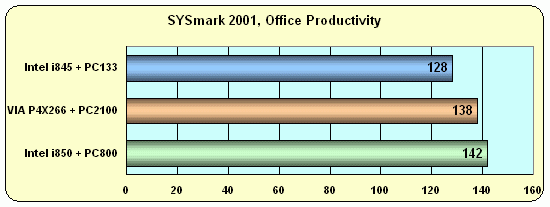 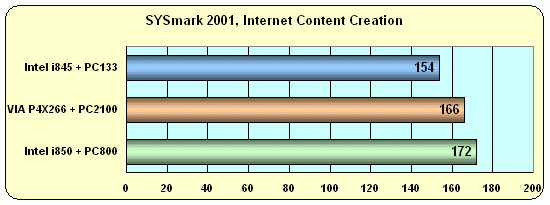 New SYSmark 2001, using more perfect model of application routine emulation and based on more up-to-date number of them, completely repeats the already known situation (that ladder is clearly seen). 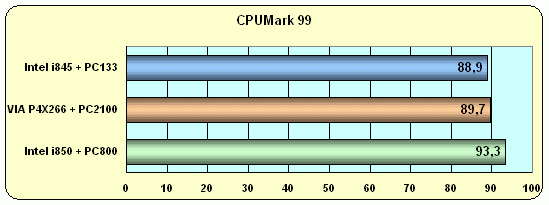  The way of memory management is traditionally the same for tests, that load CPU itself :) - the runtimes easily slips into processor cache in the majority of cases. But i850 has managed to be the first even in the CPUMark 99. ConclusionsAs it has always actually been, we've got a middle level platform from VIA, designed for the widest market segment. New P4X266 chipset is in the manner of this tradition: it doesn't lose much to the expensive and productive Intel i850 + RDRAM combo, and most likely will be faster than new Intel's Brookdale with PC133 SDRAM. In this state of affairs the price becomes the critical factor of P4X266, but Intel seems to have some reserves here. Intel completes its general objectives as well: i850 demonstrates all Pentium 4 perfomance features, and new Brookdale, soon to be announced, provides traditional stability and holds the markets for masses in combination with PC133 SDRAM, pushing Pentium 4 platforms to the mainstream segment. VIA's attitude to "new" and "old" Pentium 4 seems fairly right: P4X266 supports both CPU variants, naturally broadening the field of application. It's also nice that P4X266 supports the "good old" PC133, except the "basis" PC1600/PC2100 DDR SDRAM. VIA doesn't usually develops expensive high-end chipsets, thus we shall assume the appearance of rather cheap motherboards on the basis of P4X266 with PC133 support (some manufacturers already plan such products). And if there are "combo" boards with both PC2100 and PC133 DIMM sockets (as they are present on Apollo Pro266 and KT266), then the range of this chipset's application would be even wider. It's also interesting that VIA hasn't give up the idea of integrated graphics core in the Pentium 4 chipset, as it has done with all other platforms. P4M266 is soon to come, having modified Savage4 core (codename "Paramount") and also having 30% higher perfomance. Only time would prove, whether such integration is capable of strengthening VIA's market positions, as the upper limit of integration is "high in the sky" because of NVIDIA with nForce IGP. Multi-processor configurations remained a bit "aside" in this article. There's no mention of SMP-systems support in the P4X266 manual: as well as vice versa! And if we remember that Apollo Pro133A has suddenly "turned out" to support two CPUs in a half-year after the release, we'd not completely exclude the possibility of repeating this situation in case of P4X266. But these are still "sweet dreams": And, by the way, the analysis of increasing (decreasing) perfomance difference between i850 and P4X266 on 2+ GHz processors may become an interesting aspect of comparison. Whether the bandwidth difference may proclaim itself at such high clock rates, or the DDR / RDRAM chipsets perfomance ratio will remain the same? This research is already planned to be carried in the nearest future. Write a comment below. No registration needed!
|
Platform · Video · Multimedia · Mobile · Other || About us & Privacy policy · Twitter · Facebook Copyright © Byrds Research & Publishing, Ltd., 1997–2011. All rights reserved. |